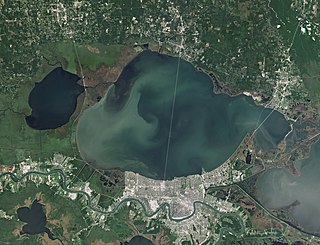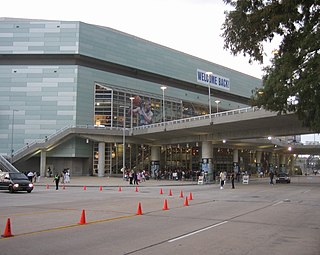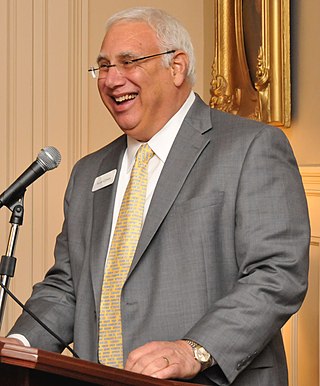
Lake Pontchartrain is an estuary located in southeastern Louisiana in the United States. It covers an area of 630 square miles (1,600 km2) with an average depth of 12 to 14 feet. Some shipping channels are kept deeper through dredging. It is roughly oval in shape, about 40 miles (64 km) from west to east and 24 miles (39 km) from south to north.
The Mississippi River–Gulf Outlet Canal is a 76 mi (122 km) channel constructed by the United States Army Corps of Engineers at the direction of Congress in the mid-20th century that provided a shorter route between the Gulf of Mexico and New Orleans' inner harbor Industrial Canal via the Intracoastal Waterway. In 2005, the MRGO channeled Hurricane Katrina's storm surge into the heart of Greater New Orleans, contributing significantly to the subsequent multiple engineering failures experienced by the region's hurricane protection network. In the aftermath the channel was closed. A permanent storm surge barrier was constructed in the MRGO in 2009, and the channel has been closed to maritime shipping.

Hurricane Katrina was a devastating and deadly Category 5 Atlantic hurricane that caused 1,392 fatalities and damages estimated at $186.3 billion in late August 2005, particularly in the city of New Orleans and its surrounding area. Katrina was the twelfth tropical cyclone, the fifth hurricane, and the third major hurricane of the 2005 Atlantic hurricane season. It was also the fourth-most intense Atlantic hurricane to make landfall in the contiguous United States, gauged by barometric pressure.

Hurricane preparedness in New Orleans has been an issue since the city's early settlement because of its location.
From 1890 through 2006, the Orleans Levee Board (OLB) was the body of commissioners that oversaw the Orleans Levee District (OLD) which supervised the levee and floodwall system in Orleans Parish, Louisiana The role of the OLB has changed over time. Prior to Hurricane Betsy in 1965, the OLB developed land and sold it to raise money to build and improve flood protection levees. After Betsy, Congress passed the Flood Control Act of 1965 which directed the Army Corps of Engineers to design and build the hurricane flood protection system enveloping New Orleans. Owing to the 1965 legislation, the OLB's duties were now limited to collecting the 30% cost share for project design and construction, and to maintaining and operating completed flood protection structures.

The 17th Street Canal is the largest and most important drainage canal in the city of New Orleans. Operating with Pump Station 6, it moves water into Lake Pontchartrain. The canal, along with the Orleans Canal and the London Avenue Canal, form the New Orleans Outfall Canals. The 17th Street Canal forms a significant portion of the boundary between the city of New Orleans and Metairie, Louisiana. The canal has also been known as the Metairie Outlet Canal and the Upperline Canal.

The London Avenue Canal is a drainage canal in New Orleans, Louisiana, used for pumping rain water into Lake Pontchartrain. The canal runs through the 7th Ward of New Orleans from the Gentilly area to the Lakefront. It is one of the three main drainage canals responsible for draining rainwater from the main basin of New Orleans. The London Avenue Canal's flood walls built atop earthen levees breached on both sides during Hurricane Katrina in 2005.
On Monday, August 29, 2005, there were over 50 failures of the levees and flood walls protecting New Orleans, Louisiana, and its suburbs following passage of Hurricane Katrina. The failures caused flooding in 80% of New Orleans and all of St. Bernard Parish. In New Orleans alone, 134,000 housing units — 70% of all occupied units — suffered damage from Hurricane Katrina and the subsequent flooding.

ING 4727 was a barge belonging to Ingram Barge Company that became infamous when it went over or through a levee and landed in a residential neighborhood of New Orleans, Louisiana during Hurricane Katrina.
The Southeast Louisiana Flood Protection Authority (SLFPA) was established by Louisiana state law Revised Statute §38:330.1 in September 2006. Its operation began in January 2007. The Authority consists of two regional levee boards which oversee flood protection in the Greater New Orleans area on the east and west banks of the Mississippi River. Commissioners of both Authorities have clearly defined term limits. The Authority also has a Nominating Committee.

When the Levees Broke: A Requiem in Four Acts is a 2006 documentary film directed by Spike Lee about the devastation of New Orleans, Louisiana following the failure of the levees during Hurricane Katrina. It was filmed in late August and early September 2005, and premiered at the New Orleans Arena on August 16, 2006 and was first aired on HBO the following week. The television premiere aired in two parts on August 21 and 22, 2006 on HBO. It has been described by Sheila Nevins, chief of HBO's documentary unit, as "one of the most important films HBO has ever made." The title is a reference to the blues tune "When the Levee Breaks" by Kansas Joe McCoy and Memphis Minnie about the Great Mississippi Flood of 1927.
Karen Carter Peterson is an American lawyer and former politician who served as a member of the Louisiana State House from 1999 to 2010, then as the state senator from the 5th district until her resignation in 2022. She also served as the chair of the Louisiana Democratic Party from 2012 to 2020, becoming the first female chair of the state party. In 2008, Peterson became as Democratic National Committeewoman for Louisiana. In 2017, Peterson was elected vice chair of civic engagement and voter participation for the Democratic National Committee.

Chris Rose is a New York Times Best-Selling New Orleans, Louisiana, writer and journalist. For years best known for light-hearted writing in the Times-Picayune, he gained greater attention for his chronicles of the effect of Hurricane Katrina on New Orleans since 2005.
The United States Army Corps of Engineers is involved with a wide spectrum of public works projects: environmental protection, water supply, recreation, flood damage and reduction, beach nourishment, homeland security, military construction, and support to other Governmental agencies. Through 19 Flood Control Acts since 1917, Congress has authorized the Corps of Engineers to be involved with flood protection and damage reduction in almost every state of the union.

Ánh Quang "Joseph" Cao is a Vietnamese–American politician who was the U.S. representative for Louisiana's 2nd congressional district from 2009 to 2011. A member of the Republican Party, he is the first Vietnamese American and first native of Vietnam to serve in Congress.
The United States Army Corps of Engineers is involved with a wide spectrum of public works projects: environmental protection, water supply, recreation, flood damage and reduction, beach nourishment, homeland security, military construction, and support to other Governmental agencies. In nineteen (19) different Flood Control Acts since 1917, the United States Congress has authorized the corps to design and build flood protection projects and one risk reduction system in the Greater New Orleans area and throughout the nation.
James Gill is a writer and a columnist from the United Kingdom.
Victor O. Ukpolo is the former Chancellor of Southern University at New Orleans.

Scott S. Cowen is president emeritus of Tulane University in New Orleans, Louisiana, where he was also Seymour S. Goodman Memorial Professor in the A.B. Freeman School of Business and professor of economics in Tulane's School of Liberal Arts. He was interim president of Case Western Reserve University in Cleveland, Ohio from 2020 to 2021, and currently serves as Distinguished Presidential Visiting Professor of Leadership and Management at CWRU. He has written more than a hundred peer-reviewed journal articles and five books. His most recent book, Winnebagos on Wednesdays: How Visionary Leadership Can Transform Higher Education, was published by Princeton University Press in 2018. Cowen is the eponym of Tulane's Cowen Institute and chairs its board of advisors. Cowen served as Tulane's 14th president from July 1998 through June 2014.
Michael Kirk Talbot is an American politician from Louisiana. A Republican, Talbot has represented the 10th district in the Louisiana State Senate since 2020, and previously represented the 78th district in the Louisiana House of Representatives between 2008 and 2020.











